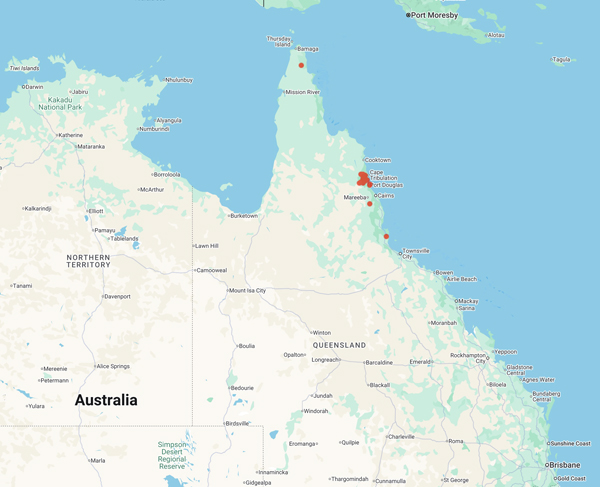 |
|
Council of Heads of Australasian Herbaria
Australian National Herbarium
Biographical Notes
|  |
 Pentzke, Theodor (c.1828 - )
Pentzke, Theodor (c.1828 - )
(His surname is variously spelt: Pentzche, Pentzcke, Pentche)
It is roughly calculated from newspaper quotes below, that Theodor was born about 1828 in Germany and had lived in north Queensland from about 1864.
We know he sent specimens to Ferdinand Mueller and corresponded with him as a 'compatriot' (although none of these letters have so far been published in the volumes of Mueller's correspondence).
There are specimens, including fungi, lichens, and mosses dating from about 1881 to 1899 in Australian and overseas herbaria: BRI, G, K, MEL, NSW.
From Mueller we get a sense that he wrote descriptively about these plants, about Bambusa arhemica he writes:
From Mr. Pentzke I received
specimens of this Bamboo as collected on affluents of the Daintree-River, which
prove it a species with hard not very hollow canes ; flowers and fruits have not
as yet been obtained ; but the sender remarks, that it reaches a height over 100
feet, and that its branches are very spreading, leaning to the adjoining trees
and growing intricately, indeed so interwovenly, that natural hedges are formed
by the plant, yet the stems are seldom gaining beyond 11 inch diameter.
(The Australasian Journal of Pharmacy, No.12, Dec 1886 p.447)
He corresponded with local newspapers on social issues:
. . . Theodore Pentzcke (Daintree)
writes to the effect that it is ridiculous rot for the black labour
barrackers to state that sugar
can't be grown in the far north
without coloured labour. Our correspondent, who is 76 years of
age, and has lived in the tropical
north for 40 years, says he works
every day out in the sun and
open, and reckons he would have
died long ago only for the healthy
climate, which he claims to be
much cooler and better than that
of the malice country in Victoria
and the hot wind districts of the
south. . . .
(Worker (Brisbane, Qld.), Sat 24 Dec 1904, Page 11, SELLING THE LAND)
In another earlier article in the German language newspaper 'Australische Zeitung' (Adelaide, SA), Wed 21 May 1890, page 4 which has been translated by Canberra botanist Alexander Schmidt-Lebuhn, the journalist cites a letter from Mueller, who mentions letters from Mr Theodor Pentzcke:
Please allow me, dear Reverent Herlitz, with some words again, to discuss the depressing circumstances under which the indigenous people in the area of the Daintree River are suffering, towards whose unfortunate circumstances public attention has been directed also in the synodal report through the excellent "Christenbote". Let me express my hope that what has been reported in the letters of Mr Theodor Pentzcke, a German landowner on that river, and on which [letters] the missionary Mr Rev. Hagenauer and I merely based our comments in the synodal assembly, will turn out to be the exception. However, it seems desirable that this our compatriot, who talks about the situation of the local indigenous people so humanely, be questioned for more details, given that the distantly located authorities are unlikely to be fully apprised of any potential atrocities.
After references to Mueller's letter, the author of the article suggests making the Bellenden-Ker Range a reservation for research, tourism, and the support of the indigenous people.
('Australische Zeitung' (Adelaide, SA), Wed 21 May 1890, page 4, Die Lage der Eingeborenen in Australien).
Sources: Extracted from:
https://archive.org/stream/indexherbar5719831988utre/indexherbar5719831988utre_djvu.txt
'THE AUSTRALASIAN JOURNAL OF PHARMACY' No.12, Dec 1886 p.447,
NEW AUSTRALIAN PLANTS;
Described by Baron Von Mueller, K.C.M.G., M. & Ph.D., F.R.S.
'Worker' (Brisbane, Qld.),
Sat 24 Dec 1904,
P.11,
SELLING THE LAND.
'The Queenslander' (Brisbane, Qld.)
Sat 19 Sep 1896,
P.553,
Ascent of Mount Alexandra.
'Australische Zeitung' (Adelaide, SA),
Wed 21 May 1890, Page 4. Die Lage der Eingeborenen in Australien.
Pers.Comm. A.Schmidt-Lebuhn (20.6.2025)
Portrait Photo: none known.
Collecting localities for 'Pentzke, T.' from AVH (2025)
Data from 387 specimens

Australian National Herbarium - updated
5 May, 2025
by webmaster (cpbr-info@anbg.gov.au)


 Pentzke, Theodor (c.1828 - )
Pentzke, Theodor (c.1828 - )